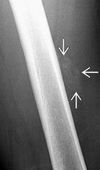Chapter 1 - Growth Adaptations, Cellular Injury, and Cell Death Flashcards
(55 cards)
What is the mechanism of the increase size in the Left Ventricle?

Hypertrophy
Hyperplasia is not possible in permanent tissues, cardiac muscle, skeletal muscle, and nerves.
What is the purpose of the Ubiquitine-Proteosome pathway?
Degradation of the cytoskeleton.
Important part of atrophy and the mechanism of cell size decrease.
Filaments are tagged by ubiquitine and removed by proteosomes.
What is the mechanism of Hypertrophy?
Gene activation, protein synthesis and organelle production.
What is the mechanism of Hyperplasia?
Generation from Stem cells.
Which Pathologic Hyperplasia does not increase the risk for cancer?
Benign prostatic hyperplasia.
What is the pathology pictured?

Barrett esophagus, the squamous cells of the esophagus undergoes metaplasia and becomes collumnar cells.
Which pathologic metaplasia does not increase the risk of cancer?
Apocrine metaplasia of the breast.
Which vitamin may be involved in Promyelocytic leukemia?
Vitamin A
15’ - 17’ translocation involves the retinoic acid receptor alpha which hinders the maturation of promyelocytes. It responds to ATRA (All-Trans Retinoic Acid) treatment.
Which deficency causes the metaplasia pictured?

Vitamin A deficency
Vit A deficency leads to metaplasia of the conjunctive (squamous to stratified keratinizing). It is called Keratomalacia.
Case: 16 year old male presents with a hard immobile mass in the right upper arm. Looking through his file you see that he had previously visited due to a bike accident three weeks previous where he had hurt his arm, but there had been no fracture on the x-rays. Worried that you may have missed something you order a new x-ray. What does it show?

Myositis ossificans
It is a form of mesenchymal metaplasia which is caused by imflamation of the muscle following trauma. It turns the muscle to bone.
Can be differantiated from osteosarcoma due to the normal viewing of the bone and the fact that the tumor is not connecte to the bone.
How can you distinguish Myositis ossificans from osteosarcome in an x-ray?

- Normal bone
- Distinct separation between the tumour and the bone.
It is a form of mesenchymal metaplasia which is caused by imflamation of the muscle following trauma. It turns the muscle to bone.
What is the two most common mechanisms of dysplasia?
- Longstanding pathologic hyperplasia
- Metaplasia
What are the common causes of Cellular injury?
- Inflammation
- Nutritional deficency
- Nutritional excess
- Hypoxia
- Trauma
- Genetic mutations
What are the common causes of Hypoxia?
- Ischemia
- Hypoxemia
- Decreased O2-carrying capacity
What is Ischemia, and what causes it?
Ischemia is decreased blood flow through an organ. Has three common causes:
- Decreased arterial perfusion (atherosclerosis)
- Decreased venous drainage (e.g., Budd-Chiari, teticular hemorraghic infarction)
- Shock (generalised hypotension)
Case: 22 year old patient presents with intense abdominal pain in the upper right quadrant. The patient has severe nausea and is quite jaundice.
The patient history is mostly unremarkable except a previous diagnosis of polycytemia vera. What illness is the patient presenting with?
Budd-Chiari syndrom
Embolous of the hepatic vein, causes infarction of the liver and may be fatal. Commonly caused by polycytemia vera (increased red bloodcells -> increased blood viscosity) or Lupus anticoagulant (causes hypercoagulant state)
What is Budd-Chiari Syndrome?
Embolous of the hepatic vein, causes infarction of the liver and may be fatal. Commonly caused by polycytemia vera (increased red bloodcells -> increased blood viscosity) or Lupus anticoagulant (causes hypercoagulant state)
What is the mechanism behind testicular hemorraghic infarction?
The testicular cord consists of a among others a thick walled artery and a thin walled vein. During testicular torsion the artery remains open but clamps off the vein. This leads to hypoxia through decreased venous drainage.
What are the 5 types of shock?
- Anaphylactic
- Cardiogenic
- Hypovolemic
- Neurogenic
- Septic
What is Hypoxemia?
It is low partial preassure of oxygen in the blood (PaO2)
What causes hypoxemia?
FiO2 → PAO2 → PaO2 → SaO2
Decreased FiO2: High altitude
Decreased PAO2: Increased PACO2 (hypoventilation, COPD)
Decreased PaO2: Diffusion defect (interstitial pulmonary fibrosis)
What causes low O2-carrying capacity of the blood?
- Anemia (PaO2 normal, SaO2 normal)
- Carbon monoxide poisioning (PaO2 normal, SaO2 low)
- Methemoglobinemia (PaO2 normal, SaO2 low)
Case: You are called out to a house fire together with the paramedics. There is only one person in the building, an elderly lady who had been found sleeping in her bedroom. The firedepartment had been alerted to the fire by a neighbour. The fire had not yet reached the bedroom of the house when the firefighters broke through the window. The woman is upset and shaken, but says she feel fine except for a light headache. You decide to take her to the hospital. What treatment should you give?
If possible the patient should be put in a hyperbaric chamber to combat the carbonmonoxide poisioning she might have developed due to smoke inhalation, while sleeping in a confined room (closed window). Headache is an early sign. It also causes dizziness, confusion, and redness of the skin. If a hyperbaric chamber is not availible she should be put on oxygen therapy.
What are the characteristic symptoms of carbonmonoxide posioning?
Cherry-red apparanca of the skin, this is caused by the tightly bound hemoglobin. It is paradoxical though because the patient is hypoxic.
OBS! Early sign is headache!










